Some like it hot – but unpredictable, climate change-fuelled spells of heat and humidity look set to play havoc with our under-cover crops.
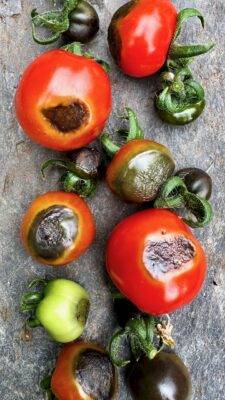
Hot, hot, hot – three heatwaves in a row, and we may not be done yet. This challenging trio has turned up the heat for gardeners everywhere. For those of us with greenhouses, conservatories, polytunnels or sun-drenched porches, boiling point has been reached more than once. In tandem with higher temperatures, we’ve also grappled with spells of such stupefying humidity that you could almost squeeze water from thin air.
This is what an ever-warming world will increasingly feel like, so we’d better get used to it, because things can only get hotter, especially for those of us sweltering under cover. Whether our greenhouse plants will be able to acclimatise to our new, unpredictable climate of growing extremes is another matter. If my tomatoes are anything to go by, there may be horticultural hiccups ahead.
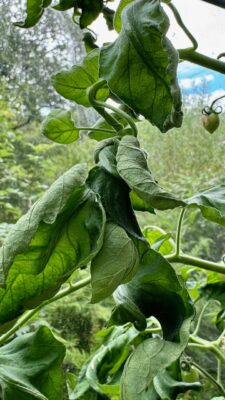
It started so well. I sowed my 10 open-pollinated tomato varieties from Wales Seed Hub on time, got excellent germination, and the first heatwave, during spring, kick-started the best batch of plants I’ve raised in my free-and-renewable-sunshine-powered greenhouse in 20 years. In some ways the non-stop – and utterly joyous – spring sunshine pushed them on a little too fast, resulting in slightly leggy but still sturdy plants anchored in quality peat-free compost (Sylvagrow Multi-Purpose).
Our endless spring (the UK’s warmest and sunniest on record) also hastened planting. I grow my tomatoes in big pots in a mix of leafmould, wormpost and any bagged leftovers of bought peat-frees. They flew away after planting, shrugging off any legginess. The first flowers soon opened. I tip-tapped them to coax fruit setting. All seemed well in my tomatoholic world.
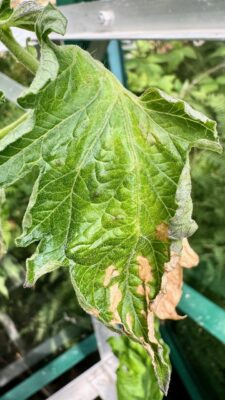
June was the warmest ever recorded in England, but we felt the heat here in Wales, too, as 2025’s second heatwave hit – which is when the heat-induced rot set in. From then on all was not well with my toms. I am writing this a few days on from when the garden thermometer hit a sweltering 31.5°C (I didn’t dare check the greenhouse reading), before tumbling 15 degrees overnight, ahead of monsoon-like downpours (a warming atmosphere holds more moisture). A typical British summer – now with the added oomph of global heating.
I’ve noticed oddities in how my tomatoes are faring; growing 10 different varieties is offering greater insight. I always expect some blossom end rot. I’ve stuck zealously to a ‘just enough’ watering/feeding regime to avoid too much humidity and deter moulds, without letting the plants dry out and wilt. That’s paid off as, despite the three heatwaves, only ‘Irish Gardener’s Delight’ has shown the rot – and only a few fruits are disfigured.
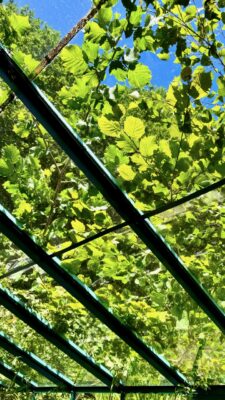
Leaf curl was something I was expecting, and I wasn’t disappointed; high temperatures trigger curling leaves, although they suffer no real damage (they don’t uncurl again). Leaf scorch was minimal; burnt foliage often appears in my greenhouse’s known hotspots, where the glass magnifies the summer sun. It’s my cue to cut leafy branches to lay over the roof as insta-shading. Scorch does no lasting harm, and the plants keep growing.
But a few plants did abruptly stop growing, and it wasn’t down to scorch. They were in the finest fettle when their shoots became wizened and dark, and growth ceased – and hasn’t restarted. Flowering faltered and young fruits were shed; it’s as if these plants simply gave up the will to grow on. This is new to me, and I can only think that some varieties can’t – quite literally – stand the heat, and that it effectively shuts them down. After slavering at the prospect of ‘Darby Striped’, the entire plant now boasts just two ripening fruits…
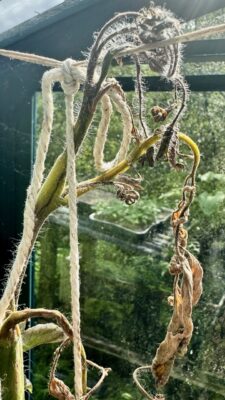
Something more familiar and insidious stopped other plants in their tracks, causing me to curse whoever allowed the poison into the compost bag in the first place (I’m looking at you, B&Q).
Twisted, buckling shoots and leaves are a sure sign of one thing: hormone weedkiller damage. I don’t use weedkillers, but they can arrive via bags of peat-free compost. The culprit blighting my toms is likely to be the residue of either clopyralid (found in lawn weedkillers) or aminopyralid (in weedkillers used on grassland). Often known as the ‘pyralids’, they still cause havoc and heartbreak for gardeners and growers. The contamination affecting my plants is almost certainly from green waste compost added to the peat-free mix; even tiny traces of pyralids cause big problems.
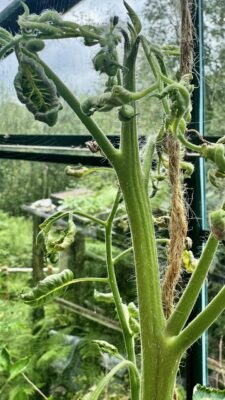
Other than the classic symptoms of distorted, tortured growth, another big clue is that the damage only appeared when the affected, otherwise healthy-looking plants reached a certain height. At first the pyralids are bound to plant tissue – such as lawn clippings, which shouldn’t go in garden waste bins – but as this rots down, they’re released and can damage sensitive crops.
Our spring heatwave didn’t set the pyralids free, but the second one did, and there’s no going back, although any fruits that have set are fine to chomp on. Another heat-driven conundrum is why only some of my tomatoes have been affected; they were all planted into the same mix. Are certain varieties less sensitive to weedkiller residues? I’m not sure this is a question that’s ever been asked, but the answer could help equip gardening with greater resilience as we grapple with the heat of inevitable change.
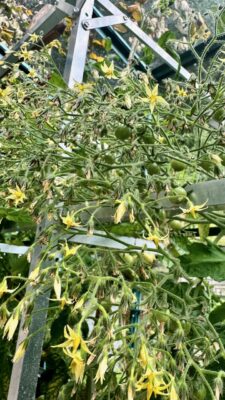
It’s cooler now, and it’s not all doom and gloom. Fruits are starting to ripen, and there’s no sign of greenback, which can be triggered by high temperatures, or of fruit splitting. Leaf moulds, which started to appear following the hot spells, are in abeyance, and hoverfly larvae have munched any aphids. The enormous trusses on ‘Yellow Clementine’ contain hundreds of flowers, each a potential cherry-sized fruit. The beefsteaks swell bigger by the day.
But there’s still ample summer left for another heatwave, for our greenhouse plants to undergo another stress-test, and for us to hone our gardening guile.
The heat is on for gardening – and it can only get hotter.
Text and images © John Walker
Join John on X @earthFgardener










